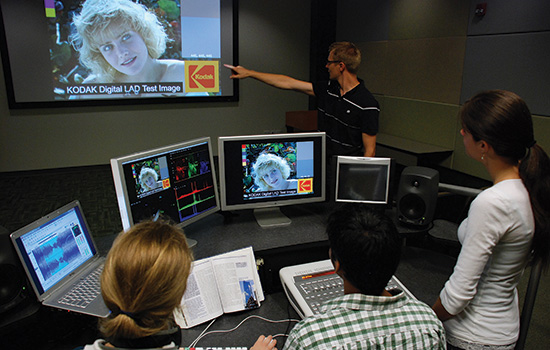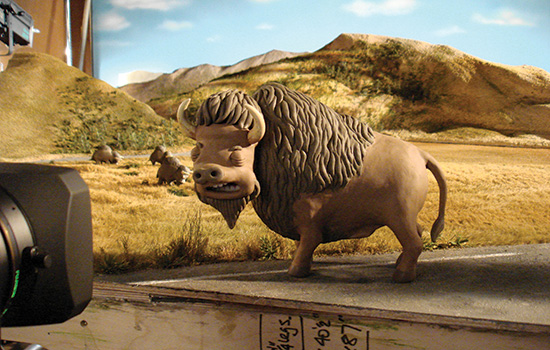Faculty serve as supporting cast to film alumni
A camera and a bit of the set can be seen in this shot of a buffalo that professor Tom Gasek animated for Aardman Animation’s Creature Comforts USA.
One professor received a technical Oscar for his work as an imaging scientist on a revolutionary motion picture film.
Another faculty member is a stop-motion animator who has contributed animation to several feature films, including Coraline and Chicken Run.
A third is a prolific filmmaker who has been honored at the Cannes International Film Festival.
Add to that an editor of films seen on HBO, a Hollywood writer and producer and a director of more than 400 television commercials for big-name companies, and you begin to get a picture of the faculty comprising RIT’s School of Film and Animation (SOFA).
Despite their varying experience, the 17 full-time professors and several adjuncts share a common purpose: to educate and inspire budding film enthusiasts before sending them off as creative professionals in the motion picture industry.
“We try to nurture filmmakers—not necessarily specialists—so that our students have the ability to continue to grow in their careers,” said Tom Gasek, a self-described “animation gypsy” and stop-motion director and animator. He has helped in the creation of a number of claymation favorites along with TV commercials of yesteryear featuring the anthropomorphized California Raisins and Wallace and Gromit.
“Many of the large studios want specialists because they have lots of people and they want everybody to be very good at one thing,” he added. “As a faculty with many different insights and experiences in this industry, we understand that strictly specializing in one thing can be a dead-end road for a creative life.”
Gasek won a Student Academy Award near the start of his career with partner Malcolm Spaull for their animated version of Lewis Carroll’s The Walrus and the Carpenter—back when both attended RIT. Spaull now serves as administrative chair of SOFA, which he joined in 1980.
“This is not your typical film school or faculty,” said Spaull, himself a filmmaker and documentarian who earned his MFA in cinematography from RIT in 1979. “We want our professors to be active practitioners—whether it be in live action, animation, sound, imaging science. If you’re going to teach it, we want you to know it from experience.”
David Long, an associate professor, was part of a group of chemical engineers and imaging scientists who developed the Vision2 color negative films that in 2008 received the Scientific-Technical Academy Award from the Academy of Motion Picture Arts and Sciences—better known as the Oscars. Actress Jessica Alba presented the statuette to Long and his fellow team members.
“This is a unique place,” said Long, who serves as chair of SOFA’s BS program in motion picture science—the only film school in the country to offer one. “Before I came to RIT, I was an imaging scientist at Kodak. We have a distinctive make-up in SOFA and a focus on filmmaking and technology here that enables us to produce not only filmmakers but contribute to the technical trades and the research of new technologies that are going to be used by industry.”
Brian Larson is an animator and designer whose credits include the TV series South Park and commercials with the Keebler Elves, Tony the Tiger of Frosted Flakes fame and Toucan Sam, the cartoon mascot for Froot Loops breakfast cereal. The RIT professor has made the transition to independent animated films—many of which promote social change.
He is currently working on a compilation film project that will feature not only his work but also that of 24 other animators from eight countries—including RIT colleagues Gasek and Carl “Skip” Battaglia, an award-winning experimental filmmaker and animator for more than three decades. At the Cannes Film Festival years ago, Battaglia’s Academy Leader Variations won best short film and the “Prix du Jury” (the Jury Prize)—considered the third most prestigious award at the French Riviera festival.
“All of us are creating pieces using the theme, ‘How I start to fly,’” Larson said. “It will be interesting to see how designers from different cultures come together to share their stories.”
Not unlike how SOFA faculty members from a wide variety of backgrounds bring together their passion for the film industry—and now teaching.
One such faculty member, Cathleen “Cat” Ashworth, is a noted documentarian who has been producing video artworks, documentaries and educational programming for more than 25 years. Widely known for seeking innovative ways to communicate visually, Ashworth’s early works combined video, performance and installation art— often from a personal point-of-view.
“Cat once did a documentary on beekeeping—and now she has become a beekeeper herself,” Spaull said.
 Associate professor David Long was part of a group of chemical engineers and imaging scientists from Kodak who in 2008 received the Scientific-Technical Academy Award from the Academy of Motion Picture Arts and Sciences.
Associate professor David Long was part of a group of chemical engineers and imaging scientists from Kodak who in 2008 received the Scientific-Technical Academy Award from the Academy of Motion Picture Arts and Sciences.








